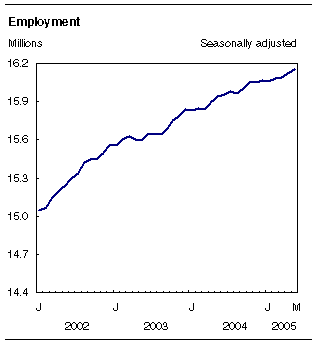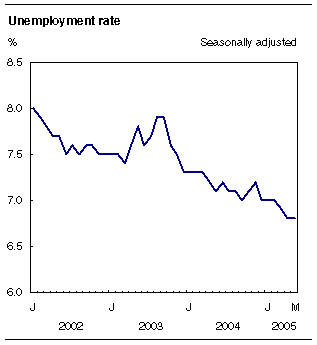
















 |
|
 |                |
Information identified as archived is provided for reference, research or recordkeeping purposes. It is not subject to the Government of Canada Web Standards and has not been altered or updated since it was archived. Please "contact us" to request a format other than those available.

|

Friday, June 10, 2005 Labour Force SurveyMay 2005Employment rose for the second consecutive month, increasing by an estimated 35,000 in May. This leaves employment up 90,000 (+0.6%) so far this year, similar to the increase over the first five months of 2004. The unemployment rate remained unchanged at 6.8%, as more people entered the labour force. 
More full-time jobs among youth and adult menBoth full- and part-time employment rose in May. So far this year, full-time employment is up 63,000 (+0.5%) compared to 28,000 (+0.9%) in part time.
Employment for men aged 25 years and over grew by 33,000 in May, mostly in full-time work. Employment for adult men has increased by 1.0% so far this year, compared with a 0.5% increase for adult women. Employment dipped slightly for adult women in May, as a decrease in full-time employment offset gains in part time. More young men and women were participating in the labour market in May, as the youth participation rate increased to 66.0% (up 0.4 percentage points). Employment among 15 to 24 year-olds increased slightly, as gains in full-time jobs (+36,000) were partially offset by losses in part time (-23,000). Youth employment remains down (-0.7%) so far this year. In May, the employment rate for 20 to 24 year-old students was 62.3%, up 2.6 percentage points from a year earlier (See Note to readers). Over the same period, the unemployment rate for this group of students decreased 1.9 percentage points to 14.9%. May's employment rate was the highest recorded in 15 years. 
Job strength in tradeAfter a decrease last month, trade employment resumed its upward trend in May, adding 45,000 jobs. Over the past 12 months, employment in trade is up 3.9%. The increase in May was primarily in motor vehicle and parts retailing, in food and beverage wholesaling and retailing and in machinery, equipment and supplies wholesaling. Employment in transportation and warehousing also increased in May (+25,000), after little change earlier in the year. Growth was mostly in truck transportation in May. Employment in business, building and other support services was up 16,000 in May, mainly in security services. Employment in this sector was otherwise flat in the previous 12 months. Agricultural employment was up 15,000 in May, with most of the growth occurring in Ontario and Quebec. Employment as a main job in this sector has rebounded 8.0% so far this year, with most of the increase in greenhouse and nursery production. However, employment in cattle farming remains down. Strength in natural resources continued in May, as 9,000 jobs were added in this industry. Gains were mainly in mining, oil and gas extraction sector and in Alberta and Ontario. Employment in this sector has increased 11.2% since April 2004, when the upward trend began. Manufacturing continued to shed jobs in May (-19,000), mostly in Ontario. This sector has declined 4.0% in the last 12 months, with 91,000 fewer manufacturing jobs. Following increases in the last few months, employment in educational services declined by 18,000 in May. Losses were predominantly in Quebec and Alberta. Construction employment retracted in May (-15,000) partially offsetting a large increase the previous month. Despite this decrease, employment in construction is up 6.3% (+59,000) since May 2004, with over half of the employment increase occurring in British Columbia. Employment growth this month was among private sector employees (+58,000), as the public sector and self-employment posted slight declines. Despite this month's large increase, employment among private sector employees is up only 0.2% since the start of this year. Job gains mostly in Ontario and British ColumbiaOntario recorded its fourth consecutive monthly increase in May (+32,000), bringing gains to 0.9% so far this year. May's increases were all in full-time work and were mainly in construction and transportation and warehousing. However, Ontario continues to show weakness in manufacturing, with 17,000 fewer jobs in May, and losses of 24,000 (-2.2%) since the end of 2004. In May, job growth continued its upward climb in British Columbia (+18,000). This leaves employment up 2.0% since the start of the year, the highest growth rate among the provinces. Most of the increase in May was in public administration and transportation. British Columbia's unemployment rate declined 0.4 of a percentage point in May to 5.7%, the second lowest on record. Following little change over the last year, employment in New Brunswick was up 4,000 in May, mostly in full time. Gains were in accommodation and food services, public administration and agriculture. In Alberta, while employment was up slightly in May, the unemployment rate decreased half of a percentage point to 3.5%, one of the lowest on record. Following little change in the previous few months, employment in Quebec fell 27,000 in May, all in full-time employment. Job losses were mostly in the public sector, as fewer jobs were recorded in health care and social assistance, public administration and educational services. The unemployment rate rose 0.6 percentage points to 8.5%. There was little change in both employment and unemployment in the other provinces in May. Available on CANSIM: tables 282-0001 to 282-0042, 282-0047 to 282-0064, 282-0069 to 282-0096 and 282-0098. Definitions, data sources and methods: survey number 3701. Available at 7:00 a.m. on our Web site. From the home page, choose Today's news releases from The Daily, then Latest Labour Force Survey. A more detailed summary, Labour Force Information, is available today for the week ending May 21 (71-001-XIE, $9/$84). The 2004 Labour Force Historical Review on CD-ROM (71F0004XCB, $209) is now available. LAN and bulk prices are available on request. Data tables are also available in the Canadian statistics module of our Web site. The next release of the Labour Force Survey will be on Friday, July 8. For general information or to order data, contact Client Services (1-866-873-8788; 613-951-4090; labour@statcan.gc.ca). To enquire about the concepts, methods or data quality of this release, contact Vincent Ferrao (613-951-4750) or Jeannine Usalcas (613-951-4720), Labour Statistics Division.
| ||||||||||||||||||||||||||||||||||||||||||||||||||||||||||||||||||||||||||||||||||||||||||||||||||||||||||||||||||||||||||||||||||||||||||||||||||||||||||||||||||||||||||||||||||||||||||||||||||||||||||||||||||||||||||||||||||||||||||||||||||||||||||||||||||||||||||||||||||||||||||||||||||||||||||||||||||||||||||||||||||||||||||||||||||||||||||||||||||||||||||||||||||||||||||||||||||||||||||||||||||||||||||||||||||||||||||||||||||||||||||||||||||||||||||||||||||||||||||||||||||||||||||||||||||||||||||||||||||||||||||||||||||||||||||||||||||||||||||||||||||||||||||||||||||||||||||||||||||||||||||||||||||||||||||||||||||||||||||||||||||||||||||||||||||||||||||||||||||||||||||||||||||||||||||||||||||||||||||||||||||||||||||||||||||||||||||||||||||||||||||||||||||||||||||||||||||||||||||||||||||||||||||||||||||||||||||||||||||||||||||||||||||||||||||||||||||||||||||||||||||||||||||||||||||||||||||||||||||||||||||||||||||||||||||||||||
|
|
|